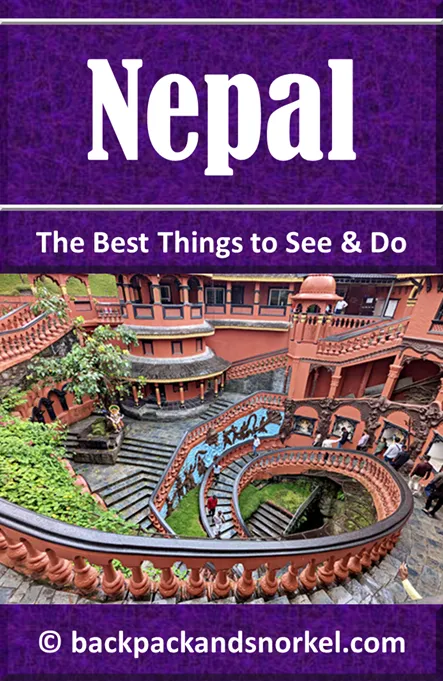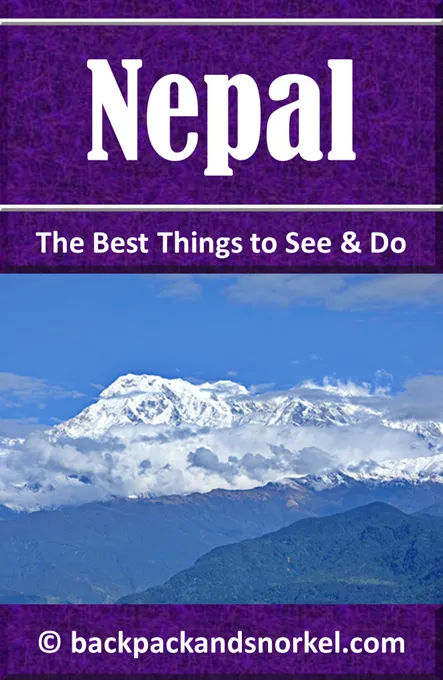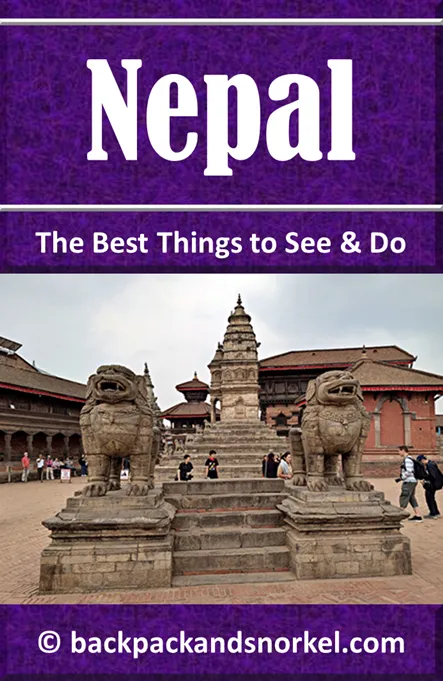Discover Nepal: Your Guide to Ancient Temples, Vibrant Culture & Stunning Views - Nepal Purple Travel Guide
Nepal! Just the name alone brings up images of towering peaks, Mount Everest, and a vibrant culture. And guess what, Nepal lives up to the hype. Without breaking the bank, this incredible country boasts eight of the world's fourteen highest mountains, drawing adventurers from across the globe to trek through its breathtaking landscapes featuring lush forests, tranquil lakes, and waterfalls that cascade down the mountainsides. Nature doesn't get much better than this.
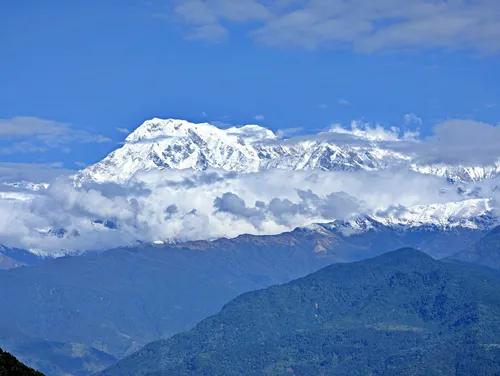

But Nepal is not just for thrill-seekers - its rich cultural heritage is just as captivating. Ancient cities filled to the brim with temples, stupas, and palaces – and the warmth and genuine hospitality of the Nepali people make for a perfect vacation.

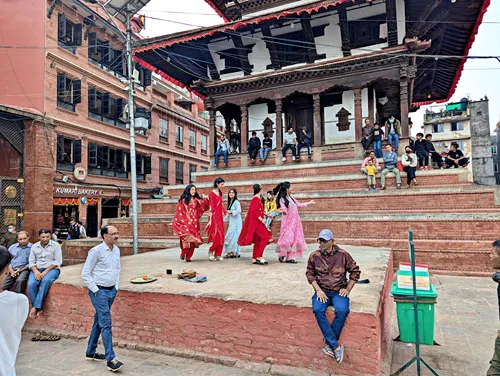
So, if you're itching to experience the best of Nepal, our Backpack and Snorkel Purple Travel Guide has you covered. We have created a 9-day itinerary that focuses on the must-see sights and experiences in Kathmandu and Pokhara, Nepal's two major cities, plus the highlights along the road that connects them.
Please note: This guide is all about exploring the cities and surrounding areas – we do not include any trekking itineraries.
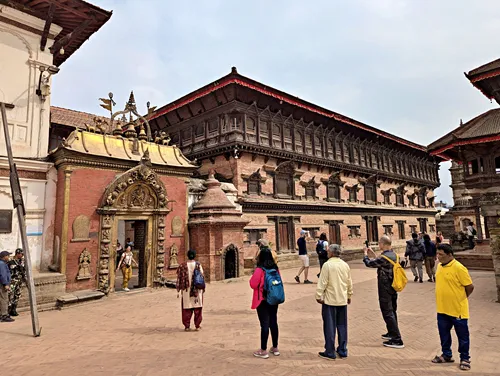



To help you plan your perfect trip, we have packed this guide with photos, links to Google Maps locations, and extra reviews, so you can easily find what sparks your interest. Come along with us as we uncover the magic of Nepal!
Here at Backpack and Snorkel Travel Guides, we typically promote self-guided walking tours.
But we realize that not everybody likes to walk by themselves in a foreign city. So, just in case that you rather go with ab guide: NO PROBLEM! Please see the Viator tours below.
free GuruWalk tours
paid Viator tours
General Information about Nepal
How much time do you need to visit Nepal?
It strongly depends on what you plan to do in Nepal. If you plan to do:
trekking, then you will spend at least several weeks, if not months in Nepal
sightseeing, then you can see the highlights of Kathmandu, and Pokhara in one week, and by adding another 4-5 days, you can see Chitwan National Park, and Buddha’s Birthplace in Lumbini, too.
In this Nepal Purple Travel Guide, we present a 9-day itinerary for Nepal that you can use as is, or you can tailor it to your interests.
What is the best time to visit Nepal?
Due to its elevations from about 190 ft (59 m) above sea level to Mt. Everest which towers at an elevation of 29,032 ft (8849 m) above sea level, Nepal is home to 5 climate zones that range from tropical climate to arctic climate.
The weather in Nepal’s two biggest cities Kathmandu and Pokhara ranges from humid subtropical climate to subtropical highland climate.
The best time to visit Kathmandu and Pokhara in Nepal is October and November, or the shoulder seasons from March to May and September.
October to November: This is the peak tourist season in Nepal – the hotel and airfares rates are at their peak. These months are generally characterized by clear skies and good-to-excellent visibility, pleasant temperatures, and dry weather.
March to May and September: This is the shoulder season. Hotel rates and airfares go down a bit and there are fewer tourists. There are generally pleasant temperatures, and in spring, you can see lots of flowers and trees bloom. The skies are generally clear, but there will be more clouds, and haze.
December to February: This is the off-season, which sees few tourists. The days are short; and the weather is cold. The skies are generally clear, but there will be more clouds than in the peak season.
June to August: This is Nepal’s monsoon season. This season has the least visitors, and frequent heavy rainfall, leading to landslides and flooding. Overland travel by car can be dangerous, or even impossible during that time. In recent years, the number of landslides on the road between Kathmandu and Pokhara is on the rise, and have led to deaths, and frequent closings. On the positive side, Nepal’s landscapes are vibrant green during that time.
Some travelers time their travels to coincide with Tihar, the Festival of Lights, which is a major Hindu festival that is celebrated in Nepal. Outside of Nepal, Tihar is better known as Diwali. Tihar and Diwali are analogous, but not the same.
Tihar is a 5-day festival that starts on the 13th day of the waning moon according to the Vikram Samvat (national Hindu) calendar. This day occurs every year in either October or November.
The following table shows the dates until 2030:
Year |
First Day of Tihar |
Last Day of Tihar |
2025 |
Nov 18 |
Nov 22 |
2026 |
Nov 8 |
Nov 12 |
2027 |
Oct 28 |
Nov 1 |
2028 |
Nov 16 |
Nov 20 |
2029 |
Nov 6 |
Nov 10 |
2030 |
Oct 26 |
Oct 30 |
Generally, visiting Nepal during Tihar is a good idea to experience the beautiful side of Nepali culture. Most, but not all, attractions will be open during Tihar, unlike during the very important Dashain festival, where almost the entire country shuts down.
Just be advised that during Tihar, some attractions that claim to stay open during holidays will close unannounced. Among those are Narayanhiti Palace Museum, and Gorkha Museum, and Gorkha Durbar.
Below is the climate that you can expect on your trip to Kathmandu in Nepal:

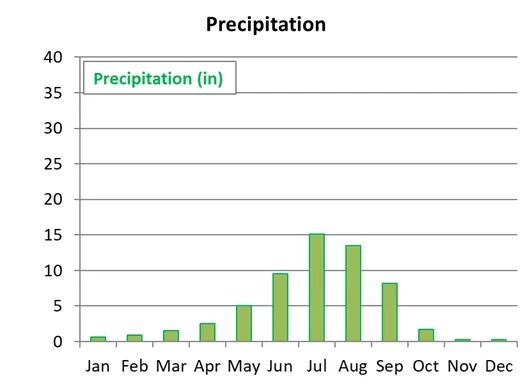
Below is the climate that you can expect on your trip to Pokhara in Nepal:
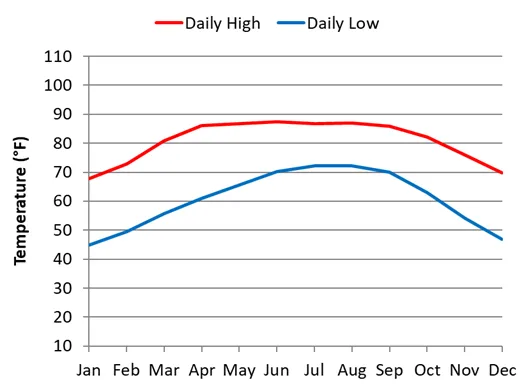
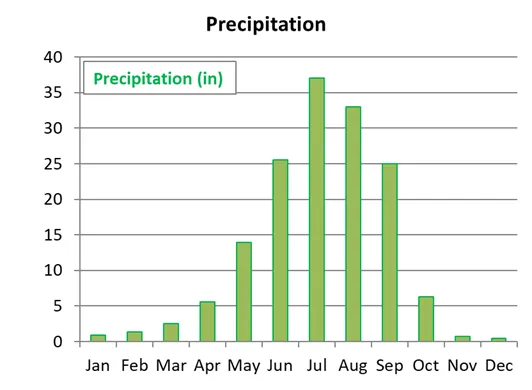
The highlights of the history of Nepal
100,000 BC: first human presence in Nepal
30,000 BC: first human settlements in Nepal
1,000 - 500 BC: Nepal is first mentioned in various Hindu texts
8th - 7th century BC: parts of what is now Nepal is ruled by the Kirat Dynasty
624 BC: Maya Devi gives birth to Siddhartha Gautama in Lumbini, who later achieves Enlightenment, and becomes Shakyamuni Buddha who founds Buddhism
600 BC: Nepal is ruled by small kingdoms and confederations of clans from the southern regions of Nepal. It is known as a land of spirituality and refuge
250 BC: the southern regions of Nepal are under the influence of the Maurya Empire. Emperor Ashoka makes a pilgrimage to Lumbini and erects Ashoka pillar at Buddha's birthplace
450 - 750 AD: Licchavi Dynasty rules the Kathmandu Valley and leaves behind a significant architectural and cultural heritage
8th – mid 11th century AD: Nepal is in its dark period under Thakuri rule, almost nothing is recorded during this time
11th century: the Khasa-Malla kingdom rules far western Nepal
11th century: during the Muslim invasion of India (Mughal period), Nepal sees an influx of high-caste Hindus from India. Both populations intermingle soon
1100: Forces from Simraungarh form a powerful kingdom in south-eastern Nepal that will last for 200 years
1201: the Malla dynasty starts ruling in the Kathmandu valley under the, but is dependent on Simraungarh until the late 14th century
14th century: the Khasa-Malla kingdom splinters into 22 Baise Rajya (sovereign and intermittently allied petty kingdoms)
Mid-15th century: Kathmandu is now a powerful empire
Late 15th century: Malla princes divide their kingdom into four kingdoms: Kathmandu, Patan, Bhaktapur, and Banepa in the east. Brotherly rivalries lead to flourishing art scenes, and architecture – the famous Kathmandu, Patan and Bhaktapur Durbar Squares are built during this period
mid-18th century: Gorkha king Prithvi Narayan Shah starts his mission to unify Nepal under his control at the Gorkha Durbar
1769: Prithvi Narayan Shah conquers the Kathmandu Valley and ends the Maller Dynasty that was already weakened by division and mistrust between the Mallers
Early 19th century: the Gorkha dominion reaches its largest expansion, and Nepal is known as Gorkha Rajya, meaning Gorkha Kingdom. The word Nepal is only used for the Kathmandu valley, the homeland of the Newars population
1814-1816: During the Anglo-Nepalese War, Nepal loses some territories to the British East India Company
1846: Rivalries within the royal family lead to a bloody feud that leads to the Kot massacre and a subsequent execution of several hundred princes and chieftains around the country. Bir Narsingh Kunwar emerges victoriously and founds the staunchly pro-British Rana dynasty. He himself comes to be known as Jung Bahadur Rana. The Shah kings are relegated to ceremonial roles. The Rana Regime is responsible for tyranny, debauchery, economic exploitation, and religious persecution
1919: the Hindu practice of Sati, in which a widow sacrifices herself in the funeral pyre of her husband, is banned
1923: the United Kingdom and Nepal formally sign the Nepal–Britain Treaty, which is the first formal acknowledgement of the British that Nepal is an independent nation, and has the right to conduct its foreign policy independently
1924: slavery is officially abolished
1930s: The name Nepal becomes the prominent way to refer to the whole country
1951: A revolution ends Rana rule and ushers in a democratic era
1960: King Mahendra scraps the democratic experiment, bans all political parties, and introduces an absolute monarchy called Panchayat system to govern Nepal. Under the Panchayat system, Nepal is modernized, reforms are introduced, and infrastructure developed, but liberties are curtailed and heavy censorship is imposed
1990: under the People's Movement, mass protests force King Birendra to restore a multi-party democracy
1996-2006: The Maoist Communist Party of Nepal wages a decade-long civil war against the government that leads to more than 16,000 deaths
2001: at the Nepalese royal massacre (Durbar Hatyakanda) at the Narayanhiti Palace, Crown Prince Dipendra shoots nine members of the royal family, including King Birendra and Queen Aishwarya, during a gathering of the royal family, and then shoots himself. According to the rules of succession, the comatose Birendra is announced king, but he dies 3 days later without ever regaining consciousness. Birendra's brother Gyanendra is then crowned king, but Nepali people are losing interest in their monarchy
2006: the Democratic Revolution of 2006 leads to the reinstatement of the old Nepal House of Representatives, a Seven Party Alliance (SPA) to bring the nation on the path to national unity, and eventually to the May 18 Act, in which the Parliament unanimously votes to strip the King of many of his powers. Even the Maoist insurgents agree to respect the outcome of free and fair elections
2008: The Nepali parliament votes to accept a new constitution which abolishes the monarchy, and turns Nepal into a federal democratic republic
2015: a 7.8 magnitude earthquake with an epicenter approx. 50 miles northwest of Kathmandu strikes Nepal. It is also known as the Gorkha earthquake. Its death toll is over 8,900 people, with tens of thousands of people injured. The earthquake causes widespread destruction of buildings, infrastructure, and cultural heritage sites, particularly in the Kathmandu Valley.
While Nepal is located in a seismically active region, and has suffered many devastating earthquakes in the past, the 2015 earthquake ranks as one of the worst due to its severe impact on the country's infrastructure, cultural heritage, and economy.
How to get around in Nepal
Traffic in Nepal is chaotic – cars share the road with lots of motorcycles, and pedestrians as there are often very few sidewalks.
The best way to get around in cities like Kathmandu and Pokhara is by using ride-sharing services like Pathao, and inDrive. Uber and Lyft do not operate in Nepal. Alternatively, many hotels have trusted drivers that you can rent for individual trips, or entire days.
The best way to travel between cities in Nepal is by plane, bus, or by hiring a car with a driver.
How to use Pathao in Nepal
Pathao is the Nepali version of uber. Its app is available on the Google Play Store and Apple App Store. Install it on your cell phone before you come to Nepal. While Pathao works very similar to uber, there are some significant differences:
You need a Nepali phone number. When you come to Nepal, you can buy a SIM card from one of the two Nepali cell phone companies NCell or Nepal Telecom (NTC). Use this phone number to register your account. You will only need this phone number once (to register your account) – the Pathao app does not require you to have the Nepali SIM card in your phone when you use it.
You will need to pay cash for each Pathao ride. The app will tell you how much each ride costs beforehand.
When using the app, Pathao will give you different comfort level options – just like uber does. Be advised that the lowest comfort level, or cheapest ride, sometimes may take place in cars that would never pass a state inspection in the US.
You will likely experience that drivers cancel your rides before they arrive multiple times. That can be due to bad traffic, or because somebody else flags them down before they get to you. You will often have a better chance of getting a ride if you don’t select the cheapest option. Cancelling rides is free for both the driver and the rider.
The Pathao app offers car rides, motorcycle rides, and even food delivery. When you book your first Pathao ride, make sure that you don’t accidentally book a motorcycle ride when you are wanting to take a car ride, motorcycle rides are shown on the top of the list.
Nepali drivers will often try to call you about the pickup place and directions to find them. I have found that it helps to text the driver ‘I am at the pickup location’ right after booking the ride – this sentence is an option that the Pathao app gives you, you just need to click on it. And if they still text you ‘call me’, then you just respond ‘no local phone’, and they will revert to texting you instead.
The Pathao app is available in English, and it displays the license plate of your driver in English letters and numbers. Unfortunately, Nepali license plates are in Nepali letters and numbers. While it is difficult to translate the letters from Nepali into English, every license plate ends with 4 (in rare cases 3) numbers.
Use the following table to translate the numbers to ensure that you can identify your driver:
How to use inDrive in Nepal
inDrive is another ride sharing app. Its app is available on the Google Play Store and Apple App Store. Unlike uber and Pathao, fares are negotiable and inDrive will suggest a fare that you can adjust up or down before you hail a ride. In my experience, inDrive often suggests fares that are higher than what Pathao quotes. You can change the fare before you send it to the app and its drivers. The higher your bid, the greater the likelihood that you will find a driver.
You will need to pay cash for each inDrive ride.
During peak hours, we sometimes found it easier to find inDrive drivers if I offered a higher fare than Pathao.
The inDrive app offers car rides, motorcycle rides, and even food delivery. When you book your first InDrive ride, make sure that you don’t accidentally book a motorcycle ride when you want to take a car ride.
The inDrive app is available in English, and it displays the license plate of your driver in English letters and numbers. Unfortunately, Nepali license plates are in Nepali letters and numbers. While it is difficult to translate the letters from Nepali into English, every license plate ends with 4 (in rare cases 3) numbers.
Use the following table to translate the numbers to ensure that you can identify your driver:
How to Fly within Nepal
Due to Nepal’s mountainous terrain, and lack of real highways, flying is often the preferred way to travel between its bigger cities. But be warned, due to unpredictable weather and winds channeled by high mountains, and runways built on small plateaus with high mountains on one side and deep drops on the other, Nepal has the highest number of aircraft crashes in the world.
The three big airlines in Nepal, that also do international flights, are: Buddha Air (website), Nepal Airlines (website), and Himalaya Airlines (website). For domestic flights, they preferably use turboprop planes like ATR42, ATR-72, and de Havilland DHC-6 Twin Otter, and Airbus A319, A320, and A330 for international flights.
There are also several small airlines that serve limited regional domestic routes.
How to Travel by Bus in Nepal
There are two types of buses in Nepal: local buses and tourist buses.
Local buses are cheap, and your seat could just be a small and barely functioning plastic chair. And you may be seated next to a goat that a local farmer is bringing to the vet. It can get terribly hot in local buses, as the only ventilation comes from open windows or doors. Some of these buses look like they may fall apart at any time.
If you have suitcases, they will likely be strapped on the top and often covered by a tarp.
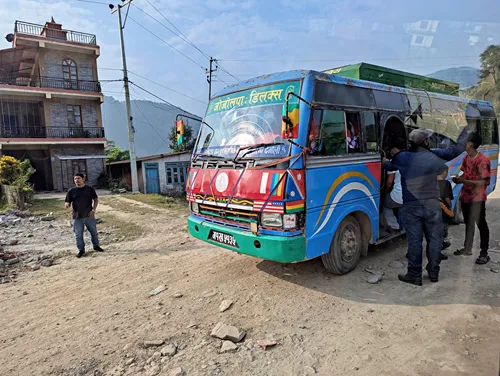
Tourist buses, however, are a bit more expensive and are higher quality buses. Unlike local buses, they don’t stop anywhere for anyone to board, and usually have A/C. But there are wide variations in size and comfort, which are reflected in the ticket categories like Deluxe, Super Deluxe, VIP Deluxe (Sofa Bus).
When you book your ticket, be advised that many overland roads, but especially the road between Kathmandu and Pokhara, are terrible and have lots of potholes. So, choose wisely when you think about your level of comfort when you book a ticket category.
On longer drives, e.g. to Pokhara, tourist buses will stop at higher class food stops and restrooms.
You can ask your hotel to book a bus for you, just be advised that their commission may be higher than on booking sites like Viator, or 12Go Asia, or local travel agencies.
Unless you come at a busy travel time, you can just show up at one of the bus stations where your bus leaves and buy a bus ticket. But be advised that Nepali overland buses tend to leave all at the same time early in the morning at 7am, and your driver may not speak English. And there is always the chance that all buses are booked out.
It is best to ask your hotel or a travel agency for the right bus stops. Overland buses tend to depart from the Tourist Bus Park near Sorhakhutte (map), and neat the Bir Hospital (map).
Even if you have a ticket and know where your bus departs, don’t expect that you will find your bus immediately, as there will likely be several buses to your destination. Just ask a bus driver or the locals for help.
There are several reputable overland bus companies in Nepal, but unfortunately, at the time of writing, none of them had a website and there are no options to reserve or pay for a seat by yourself online.
How to Rent a car with Driver in Nepal
The most renowned driver rental services are Smile Car (website), and Spark Car (website).
Spark Car is typically a bit more expensive than Smile Car. Smile Car offer transfers between cities by sedan, or SUV with a high clearance (they are typically called Jeep in Nepal), while Spark Car typically only offers transportation by Jeep.
Smile Car normally use Jeeps for parties of 3 or more people. If you travel the pothole ridden road between Kathmandu and Pokhara, we recommend renting a Jeep for this trip even if your party is only 1 or 2 people. It will still be a rough ride, but you will have a much smoother ride compared to a sedan.
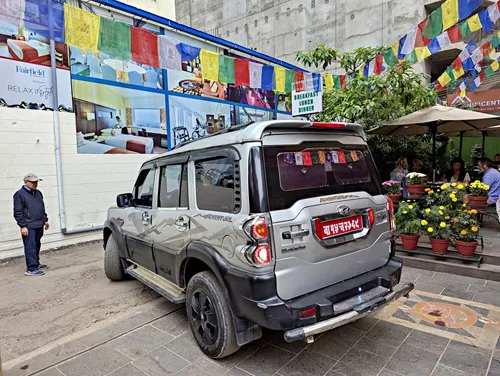
Please be advised that your rate with both companies will include the drive back (even if you only book one way), and potentially one or more hotel stays and food for the driver. If you book a return trip (e.g. from Kathmandu to Pokhara and back), then both agencies will ask you if you want to use the driver for sightseeing in the city you are going to (in this case Pokhara). This can be very convenient, but will be significantly more expensive than booking individual Pathao or inDrive rides in your destination city.
You should calculate about US$200 per day (payable in cash in advance in Nepali currency Rs) for a Jeep for full day overland drives, and less for short drives in your destination city.
Money, Credit Cards, and ATM machines in Nepal
The currency used in Nepal is the Nepalese Rupee (Rs). You can find the current exchange rate here.
Cash is king in Nepal. Credit cards (Mastercard and VISA) are often accepted in hotels, and higher-class restaurants, but these establishments may add a 3-5% credit card fee to your bill.
There are many ATM machines in Kathmandu. You will find the first ATM machine before immigration in the Kathmandu airport, and two more in the baggage claim area.
As Thamel is the most touristy part of Kathmandu, you will find many ATM machines there. Fewer, but still quite a few, can be found in Patan and Bhakthapur, and also in other tourist spots like Bandipur, and Pokhara. If you need to find an ATM, check Google maps, or ask somebody.
Our ATM Card is compatible with VISA, and we never had any problem with ATMs in Nepal.
Is it Nepali or Nepalese?
While it may be tempting to say Nepalese Food, Nepalese Currency, and Nepalese People, the word Nepalese does not exist. The correct word is Nepali, as in Nepali Food, Nepali Currency, and Nepali People.
Is tap water drinkable in Nepal
Tap water is never safe to drink in Nepal, as it has a high probability to containing bacterial contamination, which can make you sick. Even locals only drink boiled, or bottled water from one-way plastic bottles, or 5-gallon jugs.
Hotels typically provide 2 water bottles per room per day.
Having said that, you should not eat any cut fruits (unless they were cut in a large factory), as the knife may have been contaminated, and unless you are in a venue that serves foreign tourists on a regular basis.
Before eating fruits with their shells, make sure to thoroughly (!!!) wash them with bottled water, and some soap to remove all bacteria from the surface.
Because of potential bacteria contamination, only brush your teeth with bottled water. Be advised that bacteria from tap water can enter your blood stream and lead to blood poisoning if you accidentally damage your gum when brushing your teeth.
Telephone in Nepal
The country code for Nepal is: +977
Nepali SIM cards are comparably inexpensive. You can buy Nepali SIM cards in the airport, or at many stores in the touristy areas of Kathmandu and Pokhara.
At the time of writing, NCell had these prices:

In which Time Zone is Nepal
Nepal is on Nepal Time: UTC/GMT +5:45 h and does not observe Daylight saving time (DST).
You can find the current local time here.
Visa requirements for Nepal
Travelers from most countries can obtain a 15-day on-arrival Nepal visa. You can check which visa you need to enter Nepal here.
To make the visa process less complicated, we recommend:
Get your travel authorization online here. The website will only accept your entry 15 (or fewer) days before your arrival date.
Make sure to print a copy of the travel authorization that the website will provide.At the time of writing, the payment link on the website does not work.
Before you can go through immigration in Nepal, you need to go to the Visa Fee Collection Counter that is easily visible before the immigration desks and pay your visa fee in US dollar, Euro, or select other currencies.

If you don’t have any of the permitted currencies, there is an ATM from which you can withdraw cash.
There is now also one line (leftmost line) where credit card payments are accepted. This line tends to be the longest.Once you have the payment receipt, go through immigration, and then to the baggage claim area.
Languages spoken in Nepal
Nepali is the official language of Nepal. Nepal is a multi-ethnical country, whose population speaks a total of 124 languages and dialects. As such, each province is empowered to choose one or more additional official working languages.
English is widely understood and spoken by people in the tourist industry, and by store owners, and in restaurants. Many restaurants have menus in English.
We found that people often had no problem understanding us, but we often had problems understanding the locals, because they, similarly to people in India, have a different way of pronouncing vowels.
Most signs in touristy areas are in Nepali and English.
Where do you want to go now?
Author: Rudy at Backpack and Snorkel
Bio: Owner of Backpack and Snorkel Travel Guides. We create in-depth guides to help you plan unforgettable vacations around the world.
Other popular Purple Travel Guides you may be interested in:
Like this Backpack and Snorkel Purple Travel Guide? Pin these for later:

